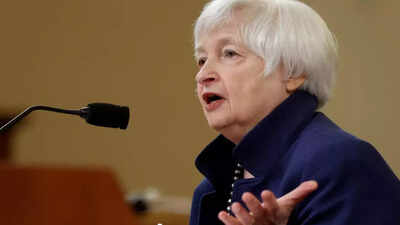Top Searches
- News
- World News
- US News
- US seeks closer ties with India as tension with China and Russia builds
US seeks closer ties with India as tension with China and Russia builds

NEW DELHI: The United States is placing India at the center of its ambition to detach global supply chains from the clutches of US adversaries, seeking to cement ties with one of the world’s fastest-growing economies as tensions with China remain high and as Russia’s war in Ukraine upends international commerce.
US Treasury Secretary Janet Yellen, the Biden administration’s top economic diplomat, delivered that message in person Friday during a visit to the Indian capital at a moment of intense global economic uncertainty. Soaring food and energy prices stemming from Russia’s war and heightened concerns about America’s reliance on Chinese products have pushed the United States to try to reshape the global economic order so that allies depend on one another for the goods and services that power their economies.
India is often in the middle of geopolitical jostling between the United States, China and Russia. But as the Biden administration promotes what it calls “friend-shoring,” it is making clear that it wants India to be in America’s orbit of economic allies.
After a tour of Microsoft’s research and development campus on the outskirts of New Delhi on Friday, Yellen outlined the case for shifting away from nations that could destabilize America’s supply chains and from manufacturers that show little regard for human life. It was evident that China and Russia were top of mind.
“The United States is pursuing an approach called ‘friend-shoring’ to diversify away from countries that present geopolitical and security risks to our supply chain,” Yellen said. “To do so, we are proactively deepening economic integration with trusted trading partners like India.”
Microsoft’s growing operations in India are an example of the integration that the United States wants to see. Yellen noted that America’s development finance agency was providing a U.S. solar manufacturer with $500 million in financing to build a facility in the south Indian state of Tamil Nadu. That is part of the administration’s effort to help the world’s solar industry move away from China, which Yellen said produces solar panels using forced labor in its Xinjiang region. And she highlighted Apple’s recent switch to move iPhone manufacturing from China to India.
“We are also addressing our reliance on manufacturers whose approaches clash with our human rights values,” added Yellen, who traveled to India before attending the Group of 20 leaders’ summit in Indonesia next week.
The importance of America’s bond with India has grown in recent months. The country is a rare ally that maintains strong diplomatic ties with Russia, which has become its top supplier of oil, and wields influence with President Vladimir Putin. At the same time, India’s large English-speaking population has the potential to make it an international production hub for U.S. companies. The United States is India’s biggest trading partner overall.
But the trade relationship has not always been easy. U.S. officials say their Indian counterparts are among the toughest negotiators, known for clinging to protectionist impulses at international meetings. And given the challenges of doing business in India, including a lack of infrastructure and government red tape, it’s not clear how many manufacturers will make the jump from China.
Sadanand Dhume, a senior fellow at the American Enterprise Institute, said India faced several challenges in becoming a hub for international manufacturing, including government reforms that had not yet “appreciably” made India a more attractive destination for companies. And compared with China, India’s domestic consumer market is smaller and therefore less attractive for companies that manufacture there.
India emerged as a significant obstacle when members of the World Trade Organization tried to reach a suite of agreements at a meeting this year. It has also declined to join negotiations over the trade pillar of the Indo-Pacific Economic Framework for Prosperity, an Asia-Pacific economic pact proposed by the Biden administration.
In the past few months, India’s long economic relationship with Russia has become increasingly problematic for the United States. India is the world’s largest buyer of Russian munitions — a relationship that is difficult to sever, particularly given India’s tensions with neighboring China and Pakistan. India has refused to condemn the Russian invasion of Ukraine. And since the war began in February, it has become a major buyer of Russian oil, which it is able to purchase on international markets at a discount.
India’s imports from Russia have risen 430% since the war in Ukraine began, as tankers of Russian crude oil flock to Indian ports. India, which imports a significant amount of energy and is the world’s second-most populous country, has said it is merely focused on buying oil at the lowest price.
Eswar Prasad, a trade policy professor at Cornell University who speaks to American and Indian officials, said that although India wanted to forge a stronger economic relationship with the United States, it was unlikely to distance itself from Russia.
“India has very deep-seated economic interests in maintaining a reliable and relatively cheap supply of oil from Russia,” said Prasad, a former official with the International Monetary Fund.
The US’ embrace of India comes as the United States and its European allies are racing to complete the terms of a plan to cap the price of Russian oil. The initiative must be in place by Dec. 5, when a European embargo and maritime insurance ban goes into effect, potentially disrupting the flow of Russian oil around the world.
The price cap would essentially create an exception to Western sanctions, allowing Russian oil to be sold and shipped as long as it remained below a certain price, a level that has yet to be determined.
India has been circumspect about the proposal, but Treasury Department officials say the United States is not trying to push it to formally join its coalition. Instead, they are hopeful that India will use the price cap as leverage to negotiate lower prices with Russia, depriving Putin of revenue but keeping the nation’s oil flowing.
US Treasury Secretary Janet Yellen, the Biden administration’s top economic diplomat, delivered that message in person Friday during a visit to the Indian capital at a moment of intense global economic uncertainty. Soaring food and energy prices stemming from Russia’s war and heightened concerns about America’s reliance on Chinese products have pushed the United States to try to reshape the global economic order so that allies depend on one another for the goods and services that power their economies.
India is often in the middle of geopolitical jostling between the United States, China and Russia. But as the Biden administration promotes what it calls “friend-shoring,” it is making clear that it wants India to be in America’s orbit of economic allies.
After a tour of Microsoft’s research and development campus on the outskirts of New Delhi on Friday, Yellen outlined the case for shifting away from nations that could destabilize America’s supply chains and from manufacturers that show little regard for human life. It was evident that China and Russia were top of mind.
“The United States is pursuing an approach called ‘friend-shoring’ to diversify away from countries that present geopolitical and security risks to our supply chain,” Yellen said. “To do so, we are proactively deepening economic integration with trusted trading partners like India.”
Microsoft’s growing operations in India are an example of the integration that the United States wants to see. Yellen noted that America’s development finance agency was providing a U.S. solar manufacturer with $500 million in financing to build a facility in the south Indian state of Tamil Nadu. That is part of the administration’s effort to help the world’s solar industry move away from China, which Yellen said produces solar panels using forced labor in its Xinjiang region. And she highlighted Apple’s recent switch to move iPhone manufacturing from China to India.
“We are also addressing our reliance on manufacturers whose approaches clash with our human rights values,” added Yellen, who traveled to India before attending the Group of 20 leaders’ summit in Indonesia next week.
The importance of America’s bond with India has grown in recent months. The country is a rare ally that maintains strong diplomatic ties with Russia, which has become its top supplier of oil, and wields influence with President Vladimir Putin. At the same time, India’s large English-speaking population has the potential to make it an international production hub for U.S. companies. The United States is India’s biggest trading partner overall.
But the trade relationship has not always been easy. U.S. officials say their Indian counterparts are among the toughest negotiators, known for clinging to protectionist impulses at international meetings. And given the challenges of doing business in India, including a lack of infrastructure and government red tape, it’s not clear how many manufacturers will make the jump from China.
Sadanand Dhume, a senior fellow at the American Enterprise Institute, said India faced several challenges in becoming a hub for international manufacturing, including government reforms that had not yet “appreciably” made India a more attractive destination for companies. And compared with China, India’s domestic consumer market is smaller and therefore less attractive for companies that manufacture there.
India emerged as a significant obstacle when members of the World Trade Organization tried to reach a suite of agreements at a meeting this year. It has also declined to join negotiations over the trade pillar of the Indo-Pacific Economic Framework for Prosperity, an Asia-Pacific economic pact proposed by the Biden administration.
In the past few months, India’s long economic relationship with Russia has become increasingly problematic for the United States. India is the world’s largest buyer of Russian munitions — a relationship that is difficult to sever, particularly given India’s tensions with neighboring China and Pakistan. India has refused to condemn the Russian invasion of Ukraine. And since the war began in February, it has become a major buyer of Russian oil, which it is able to purchase on international markets at a discount.
India’s imports from Russia have risen 430% since the war in Ukraine began, as tankers of Russian crude oil flock to Indian ports. India, which imports a significant amount of energy and is the world’s second-most populous country, has said it is merely focused on buying oil at the lowest price.
Eswar Prasad, a trade policy professor at Cornell University who speaks to American and Indian officials, said that although India wanted to forge a stronger economic relationship with the United States, it was unlikely to distance itself from Russia.
“India has very deep-seated economic interests in maintaining a reliable and relatively cheap supply of oil from Russia,” said Prasad, a former official with the International Monetary Fund.
The US’ embrace of India comes as the United States and its European allies are racing to complete the terms of a plan to cap the price of Russian oil. The initiative must be in place by Dec. 5, when a European embargo and maritime insurance ban goes into effect, potentially disrupting the flow of Russian oil around the world.
The price cap would essentially create an exception to Western sanctions, allowing Russian oil to be sold and shipped as long as it remained below a certain price, a level that has yet to be determined.
India has been circumspect about the proposal, but Treasury Department officials say the United States is not trying to push it to formally join its coalition. Instead, they are hopeful that India will use the price cap as leverage to negotiate lower prices with Russia, depriving Putin of revenue but keeping the nation’s oil flowing.
FOLLOW US ON SOCIAL MEDIA
FacebookTwitterInstagramKOO APPYOUTUBE
Start a Conversation
end of article









